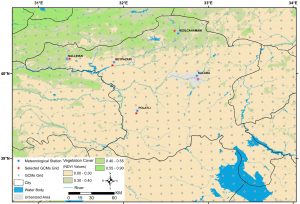In recent years, many studies found convincing evidence that climate change impacts water resources, the environment, health, and safety significantly. Typically, one of the most common methods to evaluate the impact of future climate on different processes is using simulations of general circulation models (GCMs) based on the representative concentration pathway (RCP) climate scenarios. The GCM-based datasets have been employed in many studies that are aimed to investigate the impact of climate change on drought events by considering a wide range of projections of precipitation or other climatic variables.
Many studies have investigated the impact of climate change on climatic events including droughts and runoff extremes, drought characteristics, and regionalization of droughts. The study of Afshar et al., (2020) also focuses on the investigation of climate change on the drought characteristics with consideration of joint probability. In this study, the impact of climate change on univariate and bivariate drought characteristics (duration and average severity) is investigated using long-term station-based historical observations and climate projections (three GCMs and two emission scenarios) over Ankara Province (Figure 1 and Figure 2).

Figure 1: The overall procedure of drought analysis was conducted in the study of Afshar et al., (2020). D#, duration of draught event; CDF, cumulative distribution function

Figure 2: Location of the study area (Ankara Province) that is investigated in the study of Afshar et al., (2020) and the meteorological stations located in it
The comparison of the drought characteristics shows that while over extreme droughts the average severity of drought events increases, the mild drought events will be expected to happen with longer duration and milder average severities, which implies that projection scenarios may experience more extreme precipitation deficits compared with the reference period (valid only over Ankara).
Results of the study of Afshar et al., (2020) also show that the return periods of events with low and high drought characteristic (both duration and severity) values decrease (i.e., such events will occur more frequently), while the return periods of events with medium drought duration and severity increase (i.e., such events will occur less frequently).
Overall, the joint return periods determined using copula formulations for three possible probability combinations (i.e., and, or, conditional) show that the frequency of mild drought events obtained using different GCMs will be close to those experienced in the reference period, while the return period of extreme events (i.e., drought events with return period more than 30 years) will decrease by 30%. These results imply that extreme droughts will occur more frequently in comparison with the reference time period.
The results found here should be repeated over larger regions (e.g., country scale) to make a general conclusion and determine the impacts of climate changes on mild and extreme droughts. For those who are seeking some kind of collaboration in this field, the below papers would provide beneficial information. Please contact me personally for further discussions.
Afshar, M. H., Şorman, A. Ü., Tosunoğlu, F., Bulut, B., Yilmaz, M. T., & Danandeh Mehr, A. (2020). Climate change impact assessment on mild and extreme drought events using copulas over Ankara, Turkey. Theoretical and Applied Climatology, 141(3), 1045-1055.
Danandeh Mehr, A., Sorman, A. U., Kahya, E., & Hesami Afshar, M. (2020). Climate change impacts on meteorological drought using SPI and SPEI: case study of Ankara, Turkey. Hydrological Sciences Journal, 65(2), 254-268.